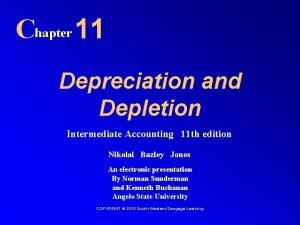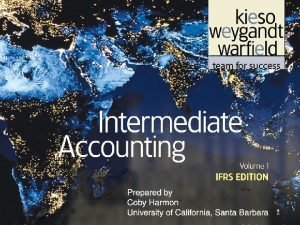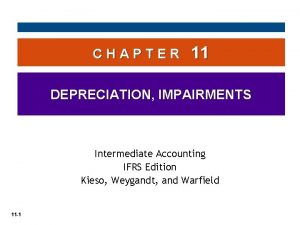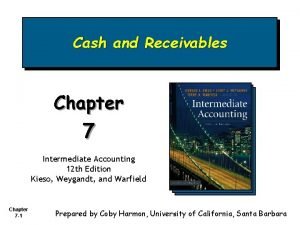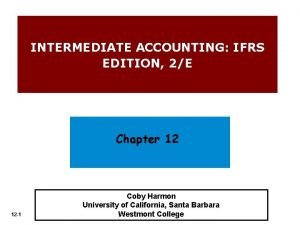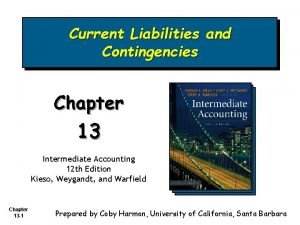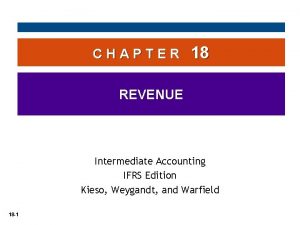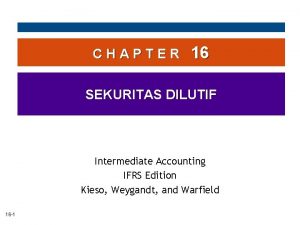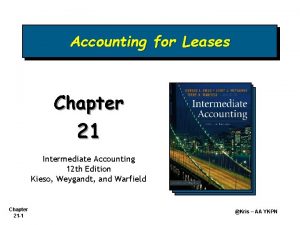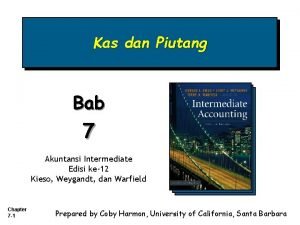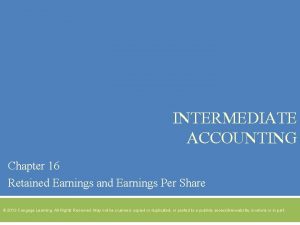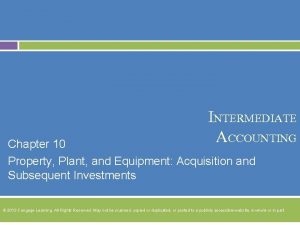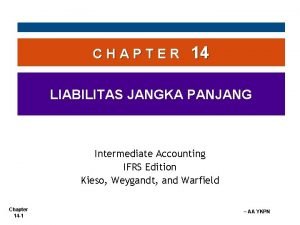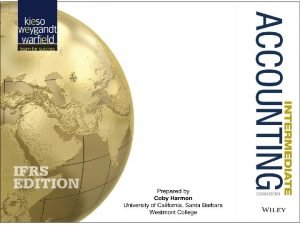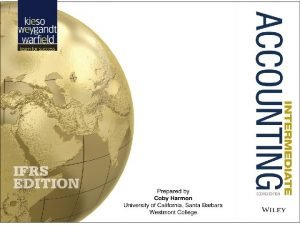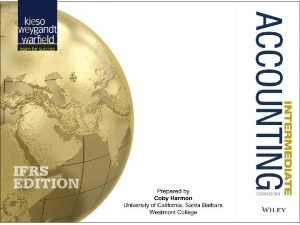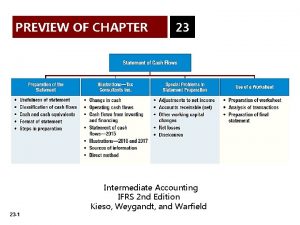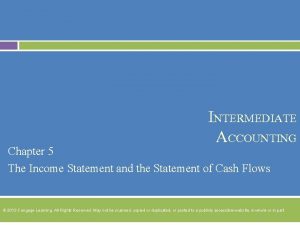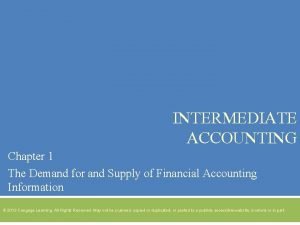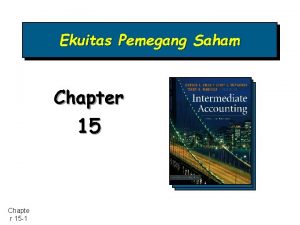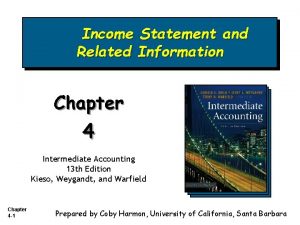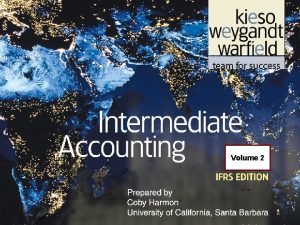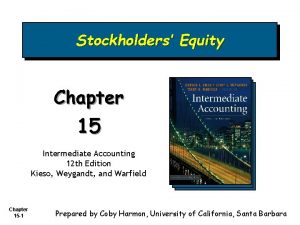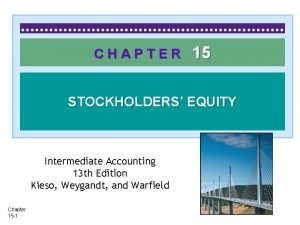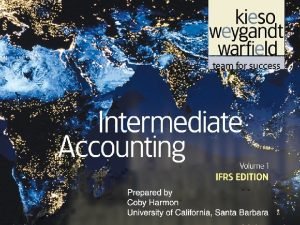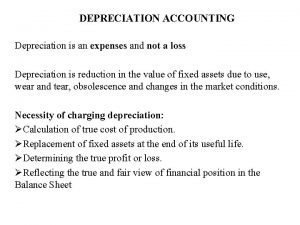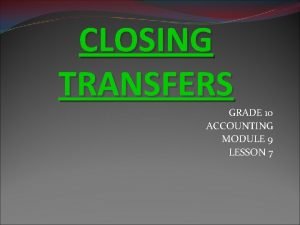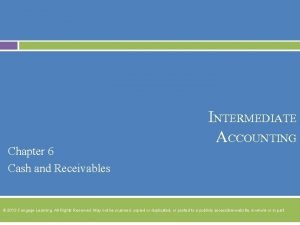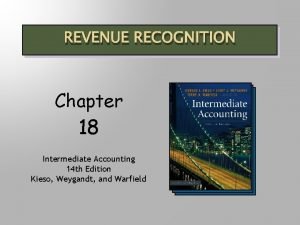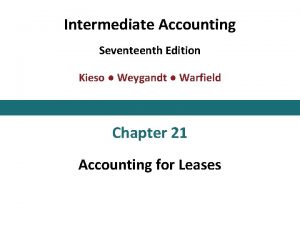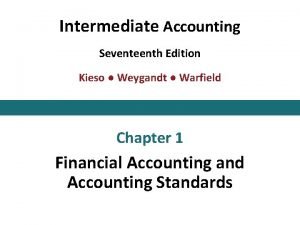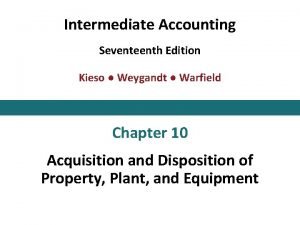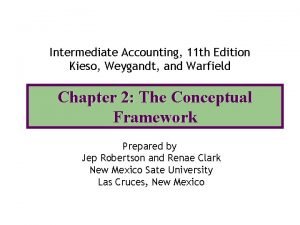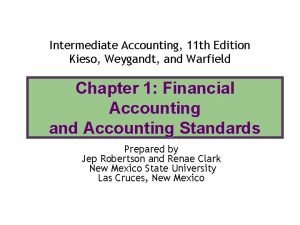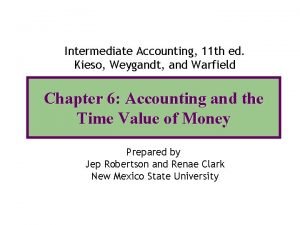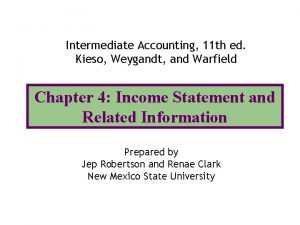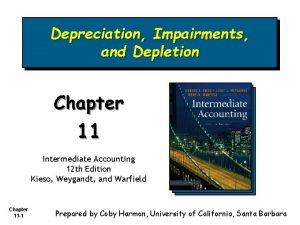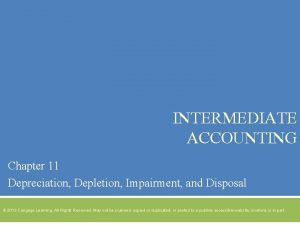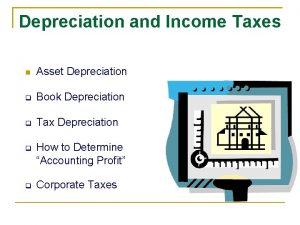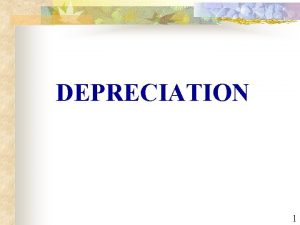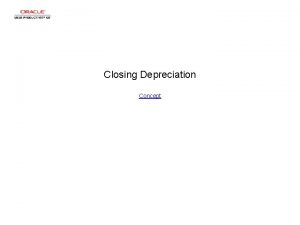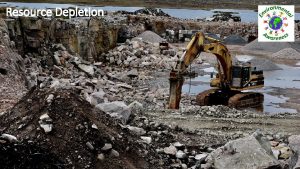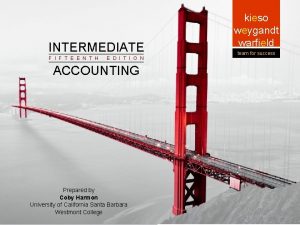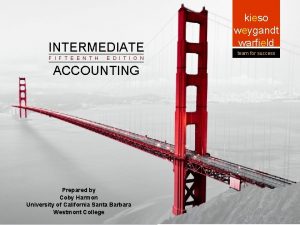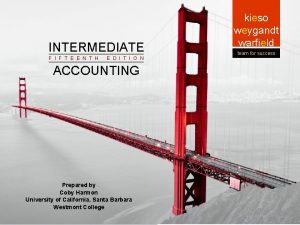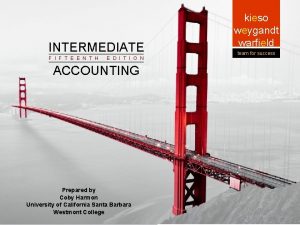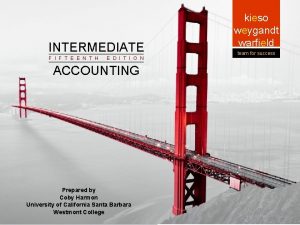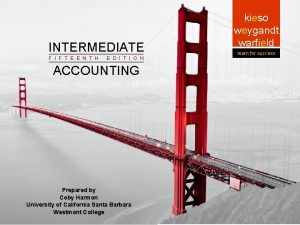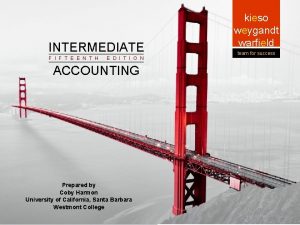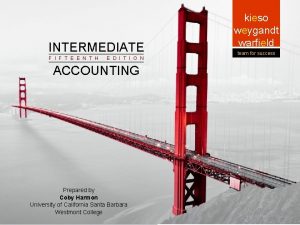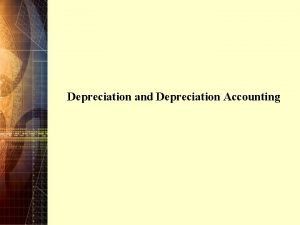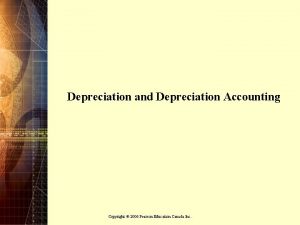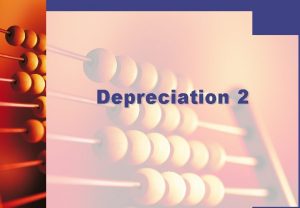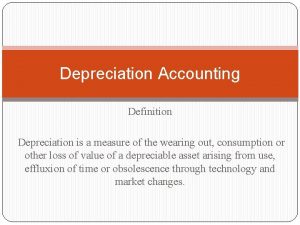Chapter 11 Depreciation and Depletion Intermediate Accounting 10














































- Slides: 46

Chapter 11 Depreciation and Depletion Intermediate Accounting 10 th edition Nikolai Bazley Jones An electronic presentation by Norman Sunderman Angelo State University COPYRIGHT © 2007 Thomson South-Western, a part of The Thomson Corporation. Thomson, the Star logo, and South-Western are trademarks used herein under license.

Factors Involved in Depreciation ü Asset cost ü Service life ü Residual value ü Method of cost allocation 2

Factors Involved in Depreciation Service Life Service life is the measure of the number of units of service expected from the asset before its disposal. 3

Factors Involved in Depreciation Service Life The factors that limit the service life of an asset can be divided into two general categories. Physical causes t Functional causes t 4

Factors Involved in Depreciation Residual Value Residual, or salvage value, is the net amount that can be expected to be obtained when the asset is disposed. 5

6 Methods of Cost Allocation v. Activity (or use) methods v. Time-based methods a. Straight-line b. Accelerated (declining charge) (1) Sum-of-the-years’digits (2) Declining balance

7 Methods of Cost Allocation Time-Based Method: Straight Line Depreciation Rate = = Cost - Residual Value Service Life $120, 000 - $20, 000 5 Years = $20, 000 per year

8 Methods of Cost Allocation Time-Based Method: Sum-of-the-Years’ Digits Years of service remaining at beginning of year Remaining 1 2 3 5 Sum-of-the-Years’-Digits = 15 (n + 1) n = 30 = 15 2 2 Years 5 43 42 1 15

9 Methods of Cost Allocation Time-Based Method: Sum-of-the-Years’ Digits Year 2006 2007 2008 2009 2010 Depreciation Book Value at Base Fraction Depreciation Year-End $100, 000 100, 000 5/15 4/15 3/15 2/15 1/15 $ 33, 333 26, 667 20, 000 13, 333 6, 667 $100, 000 $86, 667 60, 000 40, 000 26, 667 20, 000 Residual Value

10 Methods of Cost Allocation Double-Declining Balance Time-Based Method: Declining-Balance Book Value at Year Beginning of Year 2006 2007 2008 2009 2010 $120, 000 72, 000 43, 200 25, 920 20, 000 Rate Book Value at Depreciation Year-End 40% $ 48, 000 40% 28, 800 40% 17, 280 --5, 920 ----g u l P $100, 000 $72, 000 43, 200 25, 920 20, 000 Residual Value

11 Methods of Cost Allocation 150%-Declining Balance Time-Based Method: Declining-Balance Book Value at Year Beginning of Year 2006 2007 2008 2009 2010 $120, 000 84, 000 58, 800 41, 160 28, 812 Rate Book Value at Depreciation Year-End 30% $ 36, 000 30% 25, 200 30% 17, 640 30% 12, 348 --8, 812 $100, 000 $84, 000 58, 800 41, 160 28, 812 20, 000 Residual Value

12 Methods of Cost Allocation Activity Method Depreciation Rate = = Cost - Residual Value Total Lifetime Activity Level $120, 000 - $20, 000 10, 000 hours = $10 per hour Depreciation = $21, 000 (2, 100 hours. x $10) Assume the asset is used for 2, 100

13 Recording Depreciation The credit to depreciation is usually called Accumulated Depreciation or Allowance for Depreciation.

14 Conceptual Evaluation of Depreciation Methods $ Depreciation Expense Sum-of-the-Years-Digits Straight-Line Double-Declining-Balance 2006 2007 2008 2009 2010 During Year

15 Conceptual Evaluation of Depreciation Methods $ Sum-of-the-Years-Digits Book Value Straight-Line Double-Declining-Balance 2006 2007 2008 2009 2010 At End of Year

16 Conceptual Evaluation of Depreciation Methods If a company expects that repairs and maintenance costs and the total economic benefits of the asset will remain similar each period, . . .

17 Conceptual Evaluation of Depreciation Methods …a similar total cost each period can be achieved through straightline depreciation and the similar repair and maintenance costs.

18 Conceptual Evaluation of Depreciation Methods If the company expects that benefits of having the asset will decline each year for the life of the asset, . . .

19 Conceptual Evaluation of Depreciation Methods …and repairs and maintenance costs are constant each period, a declining total cost will be achieved by using accelerated depreciation.

20 Effect of Depreciation on Rate of Return Year 2006 2007 2008 2009 2010 Net Income $12, 000 12, 000 Book Value of Asset at Beginning of Year $120, 000 100, 000 80, 000 60, 000 40, 000 Rate of Return 10% 12 15 20 30

21 Disclosure of Depreciation APB Opinion No. 12 requires the following: v Depreciation expense for the period. v Balance of major classes of depreciable assets, by nature or function, at the balance sheet date. v Accumulated depreciation, either by major classes of depreciable assets or in total, at the balance sheet date. v A general description of the method or methods used in computing depreciation with respect to major classes of depreciable assets.

22 Group Depreciation A company purchased ten cars for $20, 000 each, and the average expected life is 3 years with a residual value of $5, 000 each.

23 Group Depreciation To record the purchase. Cars Cash 200, 000 $200, 000 – $50, 000 200, 000 3 expense. To record the first year’s depreciation Depreciation Expense 50, 000 Accumulated Depreciation 50, 000 This same depreciation entry would be made at in the end of the second year.

24 Group Depreciation Three cars were sold after 2 years for $8, 000 each. Cash Accumulated Depreciation Cars 24, 000 36, 000 60, 000 . 25 ($200, 000 – $60, 000) To record the third year’s depreciation expense. Depreciation Expense 35, 000 Accumulated Depreciation 35, 000

25 Group Depreciation Five cars were sold after 3 years for $6, 000 each. Cash 30, 000 Accumulated Depreciation 70, 000 Cars 100, 000 To reduce the $11, 000 book value to the salvage value. To record the fourth year’s depreciation expense. Depreciation Expense Accumulated Depreciation 1, 000

26 Group Depreciation Two. The cars final were twosold carsafter were 3 sold years forfor $4, 800 each. Cash Accumulated Depreciation Loss on Disposal Cars 9, 600 30, 000 40, 000 Book value = $10, 000 Cash received = 9, 600 Loss $ 400

27 Composite Depreciation Asset Cost A B C $25, 000 13, 000 12, 000 $50, 000 Annual Residual Value Life Depreciation $5, 000 1, 000 ----$6, 000 10 yrs. 6 4 $2, 000 3, 000 $7, 000 Depreciation Rate = = 14% $50, 000

Depreciation for Partial Periods A company purchases a $6, 000 asset with a 3 year life and no residual value on August 18. The firm uses the double-declining-balance method. 28

Depreciation for Partial Periods Annual Depreciation Year 1 2 3 4 $6, 000 x 2/3 x 4/12 ($6, 000 -$1, 333) x 2/3 ($4, 667 -$3, 111) x 2/3 Remaining balance Declining-Balance-Method = $1, 333 = $3, 111 = 1, 037 = $ 518 29

30 Impairment of Noncurrent Assets The FASB issued FASB Statement No. 144 which requires a company to review its property, plant, and equipment for impairment.

31 Impairment of Noncurrent Assets Impairment occurs whenever events or changes in circumstances indicate that the book value of a noncurrent asset may not be recoverable.

32 Impairment of a Noncurrent Asset Impairment Test If the total undiscounted cash flows are less than the book value of the asset, an impairment loss is recognized. Measurement of the Loss The loss is measured as the difference between the book value of the asset and the present value of future cash flows.

33 Impairment of a Noncurrent Asset On January 1, 2004, the Hall Company purchased a factory for $1 million (20 -year life) and machinery for $3 million (10 -year life). Late in 2007, the company believes that its asset(s) may be impaired and the remaining useful life is 5 years. The company estimates that the asset will produce cash inflows of $700, 000 and incur cash outflow of $300, 000 each year for the next 5 years.

34 Impairment of a Noncurrent Asset Impairment Test December 31, 2007 Factory cost $1, 000 Less: Accumulated depreciation (4 x $50, 000) (200, 000) Book value $ 800, 000 Machinery cost $3, 000 Less: Accumulated depreciation (4 x $300, 000) (1, 200, 000) Book value 1, 800, 000 Total Book Value $2, 600, 000

35 Impairment of a Noncurrent Asset Impairment Test Undiscounted expected net cash flows = 5 x ($700, 000 - $300, 000) Cash Years = 5 x $400, 000 Inflows Outflows = $2, 000 Because $2, 000 is less than $2, 600, 000 (the book value), an impairment loss must be recognized.

36 Impairment of a Noncurrent Asset Measurement of the Loss Undiscounted annual cash flows = $400, 000 x 3. 274294 Present value of the expected = $1, 309, 718 (rounded) cash flows (fair value) n= 5, i = 0. 16 Book value $2, 600, 000 from Table Fair value (1, 309, 718) 4 in Impairment loss $1, 290, 282 Appendix

37 Impairment of a Noncurrent Asset FASB Statement No. 121 does not specify how to record the write-down. It does indicate that the reduced book value is to be accounted for as the new cost.

38 Impairment of a Noncurrent Asset Loss from Impairment Accumulated Depreciation: Factory Accumulated Depreciation: Machinery Factory (new cost) Machinery (new cost) Factory (old cost) Machinery (old cost) 1, 290, 282 200, 000 1, 200, 000 327, 429 982, 289 1, 000 3, 000 $1, 309, 718 x [$1, 000 ÷ ($3, 000 + $1, 000)] $1, 309, 718 x [$3, 000 ÷ ($3, 000 + $1, 000)]

39 Conceptual Evaluation of Asset Impairment Although FASB Statement No. 121 has been replaced by FASB Statement No. 144, the principles it established have only changed slightly. Although the Statement narrows GAAP, it still allows for significant management flexibility.

40 Depreciation for Tax Purposes For an asset purchased in 1987 and later, the Modified Accelerated Cost Recovery System (MACRS) is required for tax purposes. A company’s computation of depreciation for income tax and financial reporting differ in three major respects: 1. A mandated tax life, which is usually shorter than the economic life. 2. The acceleration of the cost recovery (except for buildings). 3. The elimination of residual value.

41 MACRS Principles On January 1, 2006, Melville Company purchased an asset for $200, 000. The estimated economic life and MACRS life are 8 years and 5 years, respectively. The estimated residual value is $20, 000. Examine Exhibit l 1 -3 to determine the annual depreciation rate for 2006. 20% Determine depreciation for 2006 -2011.

Changes and Corrections of Depreciation v. A change in an estimate of the residual value or the service life of a currently owned asset is accounted for prospectively. v A change in the depreciation method for currently owned assets is accounted for prospectively. v Correction of an error in depreciation is treated as prior period adjustment (restatement). 42

43 Depletion v. Depletion of natural resources is calculated using the units of activity method v. Any environmental costs at the end of the project are added to the cost in determining depletion per unit

44 Depletion Cost - Residual Value Unit Depletion Rate = Units Reggio Company purchases land for $3, 000 from which it expects to extract 1, 000 tons of coal, the estimated residual value is $200, 000, and it mines 80, 000 tons of coal in the first year. $3, 000 - $200, 000 Unit Depletion Rate = 1, 000 tons

45 Depletion Cost - Residual Value Unit Depletion Rate = Units $3, 000 - $200, 000 Unit Depletion Rate = 1, 000 tons Unit Depletion Rate = $2. 80 per ton Depletion for Year = $2. 80 x 80, 000 = $224, 000

46 Chapter 11 Task Force Image Gallery clip art included in this electronic presentation is used with the permission of NVTech Inc.
 Composite depreciation
Composite depreciation Accumulated depletion
Accumulated depletion Kunci jawaban buku intermediate accounting ifrs chapter 11
Kunci jawaban buku intermediate accounting ifrs chapter 11 Non interest bearing note amortization schedule
Non interest bearing note amortization schedule Cost of retained earnings
Cost of retained earnings Intermediate accounting chapter 17 investments pdf
Intermediate accounting chapter 17 investments pdf Amortization expense formula
Amortization expense formula Chapter 13 intermediate accounting
Chapter 13 intermediate accounting Rangkuman chapter 18 revenue recognition
Rangkuman chapter 18 revenue recognition Chapter 16 kieso
Chapter 16 kieso Kieso intermediate accounting chapter 21 solutions
Kieso intermediate accounting chapter 21 solutions Tax loss carry forward
Tax loss carry forward Bab 7 kas dan piutang kieso
Bab 7 kas dan piutang kieso A restriction/appropriation of retained earnings
A restriction/appropriation of retained earnings Chapter 10 property plant and equipment
Chapter 10 property plant and equipment Chapter 2 conceptual framework
Chapter 2 conceptual framework Liabilitas jangka pendek
Liabilitas jangka pendek Chapter 3 intermediate accounting
Chapter 3 intermediate accounting Chapter 15 intermediate accounting
Chapter 15 intermediate accounting Financial accounting and accounting standards chapter 1
Financial accounting and accounting standards chapter 1 Chapter 13 intermediate accounting
Chapter 13 intermediate accounting Chapter 2 conceptual framework for financial reporting
Chapter 2 conceptual framework for financial reporting Intermediate accounting chapter 9
Intermediate accounting chapter 9 Chapter 23 statement of cash flows
Chapter 23 statement of cash flows Multi step income statement
Multi step income statement Intermediate accounting chapter 1
Intermediate accounting chapter 1 Ekuitas saham
Ekuitas saham Chapter 21 accounting for leases
Chapter 21 accounting for leases Income statement and related information chapter 4
Income statement and related information chapter 4 Intermediate accounting chapter 1
Intermediate accounting chapter 1 Under ifrs the presumption is that equity investments are
Under ifrs the presumption is that equity investments are Chapter 15 intermediate accounting
Chapter 15 intermediate accounting Intermediate accounting chapter 15
Intermediate accounting chapter 15 Chapter 12 intermediate accounting
Chapter 12 intermediate accounting Depreciation in accounting
Depreciation in accounting Grade 10 accounting depreciation
Grade 10 accounting depreciation Cash and receivables intermediate accounting
Cash and receivables intermediate accounting Lessor versus lessee
Lessor versus lessee Secured borrowing journal entries
Secured borrowing journal entries Chapter 18 revenue recognition kieso
Chapter 18 revenue recognition kieso Intermediate accounting
Intermediate accounting Accounting principles
Accounting principles Intermediate accounting
Intermediate accounting Primary qualities of accounting information
Primary qualities of accounting information Intermediate accounting
Intermediate accounting Intermediate accounting kieso
Intermediate accounting kieso Intermediate accounting kieso
Intermediate accounting kieso
